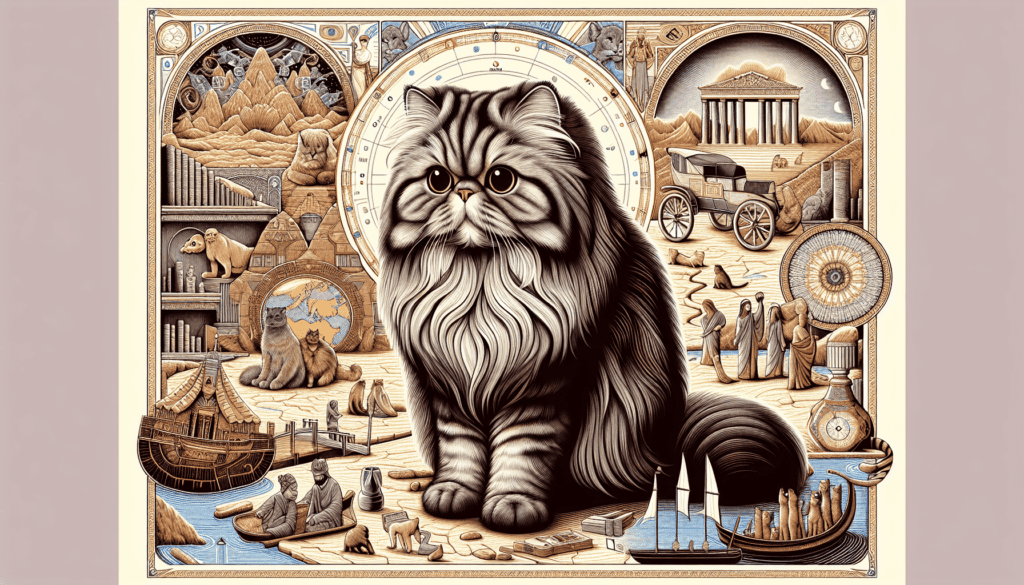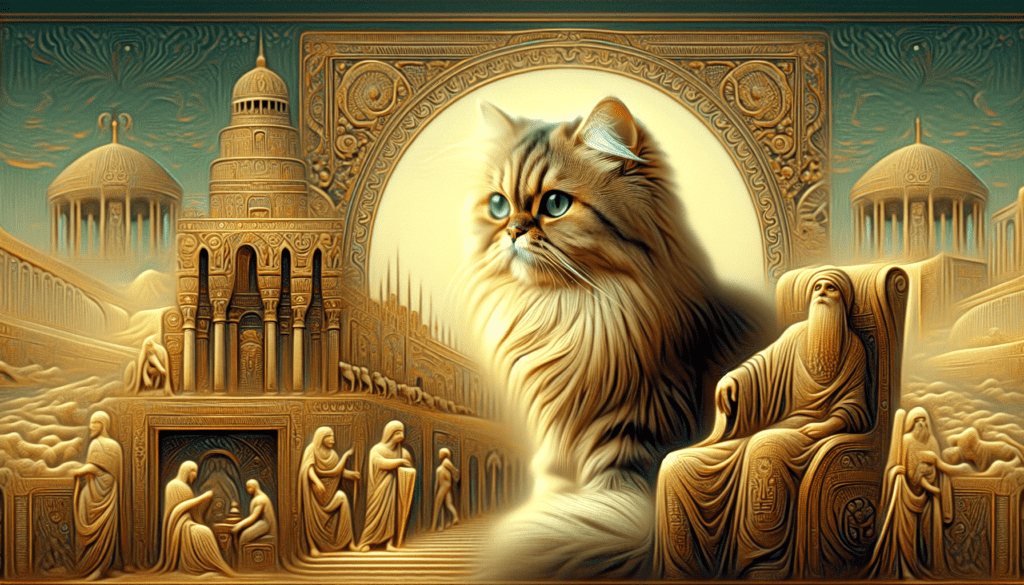Persian cats, known for their luxurious coats and captivating round eyes, have long been adored by cat lovers around the world. But have you ever wondered where these regal felines originate from? The history of Persian cats is a fascinating tale that takes us back centuries to the ancient lands of Persia, now modern-day Iran. With their captivating beauty and rich heritage, Persian cats have truly made their mark on the world of feline companionship. Let’s explore the origins and journey of these magnificent creatures together.


Evolution of Persian Cats
Primitive Origins
The origins of Persian cats can be traced back thousands of years to their primitive ancestors. These early cats are believed to have originated in the rugged mountainous regions of what is now Iran. They were well adapted to survive in harsh environments, and their long, dense fur helped protect them from the extreme weather conditions.
Developments in Persia
Over time, these primitive cats were selectively bred in Persia, now modern-day Iran, by Persian breeders who sought to enhance their unique features. The breeders were specifically interested in perfecting the cats’ long, silky coats and their distinctive round faces. Through careful breeding practices, the Persian cats gradually developed the characteristics that are now synonymous with the breed.
Spread to Europe and America
During the 17th century, Persian cats caught the attention of European travelers and were brought back to the continent as exotic pets. Their elegant appearance and gentle temperament quickly captivated the hearts of cat enthusiasts across Europe. It wasn’t long before the breed made its way to America, where its popularity soared.
Distinctive Features of Persian Cats
Physical Appearance
One of the most distinctive features of Persian cats is their strikingly beautiful appearance. They have a stocky body with short legs and a broad chest. Their faces are characterized by round, expressive eyes, a flat nose, and pronounced cheeks. These physical features give them a unique and endearing look that sets them apart from other cat breeds.
Coat and Color Variations
The Persian cat’s luxurious and long-haired coat is undoubtedly one of its most recognizable features. Their coats come in a wide array of colors, ranging from solid shades to intricate patterns. Popular coat colors include white, black, cream, blue, silver, and more. Additionally, Persians can have various coat patterns, such as tortoiseshell, tabby, calico, and colorpoint.
Facial Structure
The facial structure of Persian cats is a defining characteristic of the breed. Their round faces are complemented by large, expressive eyes that come in various shades, including blue, green, and copper. The flat nose and well-developed cheeks give them a sweet and gentle expression, adding to their undeniable charm.
Historical Importance of Persian Cats
Royal Companions
Throughout history, Persian cats held a special place in the hearts of royalty. They were often treasured companions of noble and royal individuals, including Persian kings and queens. Their striking beauty and regal demeanor made them a symbol of prestige and luxury.
Symbol of Luxury
Not only were Persian cats beloved by royalty, but they also became a status symbol for the wealthy elite in various societies. Their lush coat, captivating eyes, and overall elegance contributed to their association with luxury and refined taste. Owning a Persian cat was a statement of wealth and sophistication.
Presence in Cultural Artifacts
Persian cats have influenced numerous cultural artifacts throughout history. They are frequently depicted in ancient Persian manuscripts, paintings, and tapestries. Their graceful presence in these artworks reflects the high regard in which they were held by artists and society alike.
Popularity and Breed Standards
Introduction to the West
Persian cats were introduced to the Western world during the height of the British Empire. British diplomats and merchants traveling to the Middle East were enchanted by these captivating felines and brought them back to England. From there, the breed gained popularity across Europe and eventually made its way to America.
Classification and Standards
Over time, breed standards were established to ensure that Persian cats maintained their distinctive characteristics. These standards define the ideal physical features, temperament, and coat variations of the breed. Organizations such as the Cat Fanciers’ Association (CFA) and The International Cat Association (TICA) play a significant role in maintaining and refining these breed standards globally.
Breeding Challenges
Breeding Persian cats comes with its own set of challenges. Their long, dense coats require regular grooming to prevent matting and tangles. Additionally, the flat facial structure of Persians can lead to health issues, such as respiratory problems and eye infections. Responsible breeders carefully select breeding pairs and prioritize the health and well-being of the cats.


Breeding and Care
Selective Breeding Practices
Selective breeding has played a crucial role in developing the desirable traits of Persian cats. Breeders meticulously choose mating pairs based on their conformation to breed standards, health history, and genetic diversity. Through careful selection, breeders aim to maintain and improve the breed’s physical characteristics, temperament, and overall well-being.
Health Concerns and Care Recommendations
While Persian cats are known for their beauty, they also have specific health concerns that owners should be aware of. Respiratory issues, dental problems, and polycystic kidney disease (PKD) are among the common health conditions seen in the breed. Regular veterinary check-ups, a balanced diet, and a clean living environment are essential for maintaining the health and well-being of Persian cats.
Grooming Requirements
Due to their long, thick fur, Persian cats require regular and meticulous grooming. Daily brushing helps prevent matting and tangling, reducing the risk of skin irritations. Regular bathing is also necessary to keep their coats clean and free from dirt and oils. Additionally, routine eye and ear cleaning should be part of the grooming routine to ensure overall hygiene.
Persian Cats in Popular Culture
Film and Television
Persian cats have made their way into popular culture through various films and television shows. Their graceful and regal appearance has often been used to depict aristocratic characters, adding an air of sophistication to the silver screen. They have become iconic representations of elegance and beauty in the entertainment industry.
Literature and Art
Throughout literary history, Persian cats have been featured in stories, poems, and novels. Their captivating and enigmatic personalities have inspired authors to incorporate them into their works. In art, Persian cats have been depicted in traditional paintings and modern interpretations alike, showcasing their timeless appeal as subjects of admiration.
Social Media Influences
In the digital age, Persian cats have gained significant popularity on social media platforms. Photos and videos showcasing their photogenic nature, unique personalities, and adorable antics have garnered a large following of cat lovers worldwide. The internet has provided a platform for showcasing the charm and allure of Persian cats on a global scale.
Current Status and Conservation Efforts
Global Distribution
Today, Persian cats can be found in homes all around the world. Their popularity has spread far and wide, with dedicated breeders ensuring the preservation of their distinct characteristics. From Europe and America to Asia and beyond, Persian cats have established their place as beloved pets in households across continents.
Concerns of Inbreeding
The breed’s popularity has also led to concerns of inbreeding, which can lead to various genetic health issues. Responsible breeders prioritize genetic diversity and carefully plan their breeding programs to minimize the risk of inherited disorders. Collaboration among breeders and breed clubs plays a crucial role in maintaining the health and genetic integrity of the Persian cat population.
Conservation and Preservation
Conservation efforts are in place to ensure the long-term preservation of Persian cats. Genetic research is being conducted to identify and address potential health issues within the breed. Conservation organizations work closely with breeders to implement breeding practices that prioritize the health and well-being of Persian cats, securing their future as a treasured and cherished breed.
Persian Cats as Pets
Temperament and Personality Traits
Persian cats are known for their sweet and gentle temperament, making them wonderful companions. They are typically calm, affectionate, and enjoy a relaxed lifestyle. These cats thrive in peaceful environments where they can receive ample attention and affection from their owners.
Suitability for Families and Individuals
Persian cats are well-suited for families and individuals alike. Their docile nature and adaptability make them ideal pets for households with children. They are patient and tolerant, making them excellent companions for people of all ages. Whether living in a busy household or with a single owner, Persian cats can provide loyal and constant companionship.
Training and Socialization
Proper training and socialization are essential for Persian cats from an early age. They benefit from positive reinforcement training methods that reward good behavior and discourage unwanted habits. Gentle socialization with other animals and exposure to various environments help ensure they grow into well-adjusted and confident feline companions.
The Future of Persian Cats
Advancements in Genetic Research
Advancements in genetic research offer promising opportunities for the future of Persian cats. Understanding the breed’s genetics can help identify and address potential health issues, leading to improved overall health and well-being. Genetic testing and counseling can provide valuable information to breeders, allowing them to make informed breeding decisions.
Hybrid Breeding Experiments
Hybrid breeding experiments involving Persian cats and other breeds can lead to the development of new and unique breeds. These experiments aim to combine the best traits of various breeds while preserving the desirable characteristics of the Persian cat. The results of these experiments could bring forth exciting and diverse feline companions in the future.
Potential Crossbreeds
The Persian cat’s distinct physical features and gentle demeanor make it an attractive breed for crossbreeding. Potential crossbreeds may include breeds such as the Siamese, Maine Coon, or Ragdoll, among others. These efforts offer exciting possibilities for the creation of hybrid breeds that combine the best traits of the Persian cat with other popular and beloved feline companions.
Conclusion
The legacy of Persian cats is undeniable. Their journey from their primitive origins to their current status as one of the most beloved and admired cat breeds is a testament to their enduring appeal. From their distinctive physical features to their regal presence in history and culture, Persian cats have left an indelible mark on the feline world. Through responsible breeding, care, and conservation efforts, Persian cats will continue to grace our lives with their beauty, charm, and unwavering companionship.

